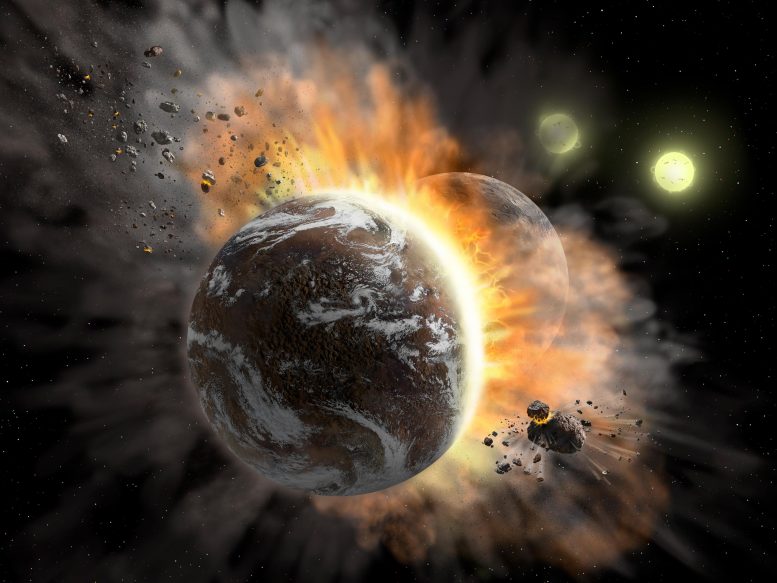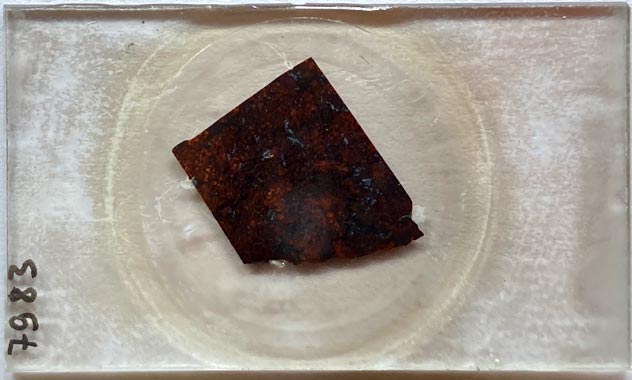
International research team solves theory of how diamonds formed inside protoplanets.
Geoscientists from Goethe University have found the largest extraterrestrial diamonds ever discovered – a few tenths of a millimeter in size nevertheless – inside meteorites. Together with an international team of researchers, they have now been able to prove that these diamonds formed in the early period of our solar system when minor planets collided together or with large asteroids. These new data disprove the theory that they originated deep inside planets – similar to diamonds formed on Earth – at least the size of Mercury.
It is estimated that over 10 million asteroids are circling the Earth in the asteroid belt. They are relics from the early days of our solar system, when our planets formed out of a large cloud of gas and dust rotating around the sun. When asteroids are cast out of orbit, they sometimes plummet towards Earth as meteoroids. If they are big enough, they do not burn up completely when entering the atmosphere and can be found as meteorites. The geoscientific study of such meteorites makes it possible to draw conclusions not only about the evolution and development of planets in the solar system but also their extinction.

A special type of meteorites is ureilites. These are fragments of a larger celestial body — probably a minor planet — which was smashed to pieces through violent collisions with other minor planets or large asteroids. Ureilites often contain large quantities of carbon, among others in the form of graphite or nanodiamonds. The diamonds on a scale of over 0.1 and more millimeters now discovered cannot have formed when the meteoroids hit the Earth. Impact events with such vast energies would make the meteoroids evaporate completely. That is why it was so far assumed that these larger diamonds — similar to those in the Earth’s interior — must have been formed by continuous pressure in the interior of planetary precursors the size of Mars or Mercury.

Together with scientists from Italy, the USA, Russia, Saudi Arabia, Switzerland, and Sudan, researchers from Goethe University have now found the largest diamonds ever discovered in ureilites from Morocco and Sudan and analyzed them in detail. Apart from the diamonds of up to several 100 micrometers in size, numerous nests of diamonds on just nanometer scale as well as nanographite were found in the ureilites. Closer analyses showed that what is known as lonsdaleite layers exist in the nanodiamonds, a modification of diamonds that only occurs through sudden, very high pressure. Moreover, other minerals (silicates) in the ureilite rocks under examination displayed typical signs of shock pressure. In the end, it was the presence of these larger diamonds together with nanodiamonds and nanographite that led to the breakthrough.
Professor Frank Brenker from the Department of Geosciences at Goethe University explains:
“Our extensive new studies show that these unusual extraterrestrial diamonds formed through the immense shock pressure that occurred when a large asteroid or even minor planet smashed into the surface of the ureilite parent body. It’s, by all means, possible that it was precisely this enormous impact that ultimately led to the complete destruction of the minor planet. This means — contrary to prior assumptions — that the larger ureilite diamonds are not a sign that protoplanets the size of Mars or Mercury existed in the early period of our solar system, but nonetheless of the immense, destructive forces that prevailed at that time.”
Reference: “Impact shock origin of diamonds in ureilite meteorites” by Fabrizio Nestola, Cyrena A. Goodrich, Marta Morana, Anna Barbaro, Ryan S. Jakubek, Oliver Christ, Frank E. Brenker, M. Chiara Domeneghetti, M. Chiara Dalconi, Matteo Alvaro, Anna M. Fioretti, Konstantin D. Litasov, Marc D. Fries, Matteo Leoni, Nicola P. M. Casati, Peter Jenniskens and Muawia H. Shaddad, 28 September 2020, Proceedings of the National Academy of Sciences.
DOI: 10.1073/pnas.1919067117
The international research team comprises scientists from the following institutions:
- Department of Geosciences, University of Padova, Italy
- Department of Geosciences, Goethe University, Frankfurt, Germany
- Lunar and Planetary Institute, USRA, Houston, Texas, USA
- Department of Earth and Environmental Sciences, University of Pavia, Italy
- Astromaterials Research and Exploration Science Division, Jacobs JETS, Johnson Space Center, NASA, Houston, Texas, USA
- CNR Institute of Geosciences and Earth Resources, Padua, Italy
- Vereshchagin Institute for High Pressure Physics RAS, Troitsk, Moscow, Russia
- NASA Astromaterials Acquisition and Curation Office, Johnson Space Center, NASA, Houston, Texas, USA
- Department of Civil, Environmental and Mechanical Engineering, University of Trento, Italy
- Saudi Aramco R&D Center, Dhahran, Saudi Arabia
- Swiss Light Source, Paul Scherrer Institute, Villigen, Switzerland
- SETI Institute, Mountain View, California, USA
- Department of Physics and Astronomy, University of Khartoum, Khartoum, Sudan
Never miss a breakthrough: Join the SciTechDaily newsletter.
6 Comments
I made a discovery approx 30 years ago in the Highlands of the rural RougeValley Note we are 150 to 200 ft above Lake Ontario just northeast of
Toronto,Ontario Canada., While excavating a
Swimming pool hole, at a depth of 7 1/2 to 8ft
Deep the backhoe bucket started dropping heàvy
Round white lonsdaliete stones they are so hard you can not scratch or break no other stones or rocks came out just soil. Theses lonsdaliete diamond stones would have been form from extreme pressure and heat from the meteorite entering the atmosphere and the explosion would have created the crate hole
that I found during my excavatiion of the swimming pool,note the stones react to a diamond tester.,I retreved about 10 to 15 stones. I am interested in getting these stones authenticized. an will to share my discovery,Upon my retirement and research
they have all the characteristics of lonsdaliete diamonds. Can send pictures or can be seen.
Swimming pool hole
I m daimond bigness
I found a substantial Supply of londsdalite here on the coast in San Diego. Please let me know if you’re interested in my tiny Diamond Supply. I have many pieces of an asteroid that crashed off our Coast millions of years ago… Boone
I have also discovered some stones that show they originate from pressure and heat in the dome crater in South Africa known as the Fredefort Dome crater astamete 2-300 big. These crystals are of exagone types and cubig.
I think I have a metorit that has diamonds in it and gold ,iron….
My name is Jeff and I live in Gettysburg. I have the largest collection of space rocks in the United States. And it’s all early on the alien diamond planet. Are even found meteorite cases that destroyed a diamond planet. SI only have 2 little features that I found so they’re precious.